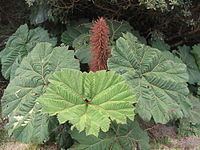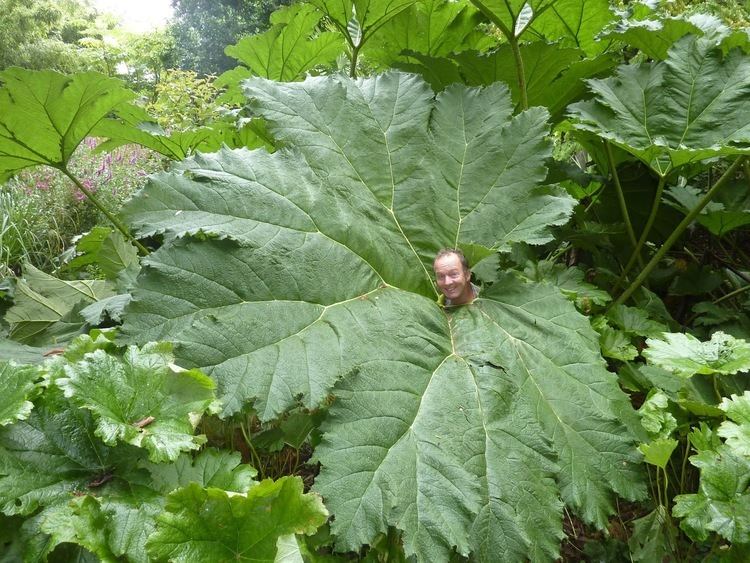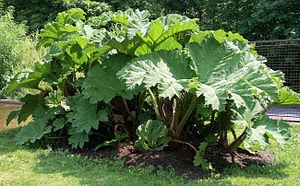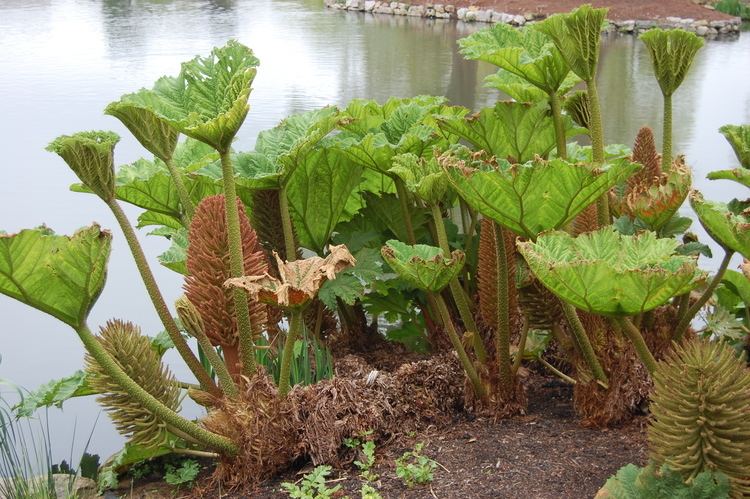Scientific name Gunnera Rank Genus | Family Gunneraceae Higher classification Gunneraceae Order Gunnerales | |
Lower classifications Gunnera manicata, Chilean rhubarb, Gunnera aequatoriensis | ||
Giant gunnera plant timelapse 3 months of growth
Gunnera is a genus of herbaceous flowering plants. Some species have extremely large leaves. Species in the genus are variously native to Latin America, Australia, New Zealand, Papuasia, Hawaii, insular Southeast Asia, Africa, and Madagascar. The stalks of many species are variously edible, and a cultivar from South America is commonly eaten raw.
Contents
- Giant gunnera plant timelapse 3 months of growth
- Gunnera manicata rhubarbe g ante du chili the tonettes i ll give it to you
- Description
- Ecological attributes
- Taxonomy
- Cyanobacterial symbiosis
- Uses
- References

Gunnera manicata rhubarbe g ante du chili the tonettes i ll give it to you
Description

The 40–50 species vary enormously in leaf size. The Giant Rhubarb, or Campos des Loges (Gunnera manicata), native to the Serra do Mar mountains of southeastern Brazil, is perhaps the largest species, with reniform or sub-reniform leaves typically 1.5 to 2.0 meters (4.9 to 6.6 ft) long, not including the thick, succulent petiole which may be up to 2.5 meters (8.2 feet) in length. The width of the leaf blade is typically 2.5 meters (8.2 feet), but on two separate occasions cultivated specimens (In Berkshire, England in 2011 and at Narrowwater, Ulster, Ireland in 1903) produced leaves fully 3.3 meters (11 feet) in width, not far from the largest of all dicot leaves such as Victoria amazonica. The seeds germinate best in very moist, but not wet, conditions and temperatures of 22–29 °C.

Only slightly smaller is G. masafuerae of the Juan Fernandez Islands off the Chilean coast. They can have leaves up to 2.9 m (9 ft 6 in) in width on stout leaf stalks 1.5 m (4.9 ft) long and 11 cm (4.3 in) thick according to Skottsberg. these leafstalks or petioles are the thickest of any dicot, and probably also the most massive. On nearby Isla Más Afuera, G. peltata frequently has an upright trunk to 5.5 m (18 ft) in height by 25–30 cm (9.8–11.8 in) thick, bearing leaves up to 2 m (6 ft 7 in) wide. The Hoja de Pantano (G. magnifica) of the Colombian Andes bears the largest leaf buds of any plant; up to 60 cm (2.0 ft) long and 40 cm (16 in) thick. The succulent leaf stalks are up to 2.7 m (8 ft 10 in) long. The massive inflorescence of small, reddish flowers is up to 2.3 m (7 ft 7 in) long and weighs about 13 kg. Other giant Gunnera species are found throughout the Neotropics and Hawaii.

Several small species are found in New Zealand, notably G. albocarpa, with leaves only 1–2 cm long, and also in South America, with G. magellanica having leaves 5–9 cm wide on stalks 8–15 cm long.
Ecological attributes

At least some species of Gunnera host endosymbiotic cyanobacteria, such as Nostoc punctiforme; studies suggest that the cyanobacteria provide fixed nitrogen to the plant, while the plant provides fixed carbon to the microbe.
Taxonomy
The genus Gunnera was named after the Norwegian botanist Johann Ernst Gunnerus. At first it was assigned to the family Haloragaceae, though that did present difficulties that led to the general recognition of the family Gunneraceae, as had been proposed about the beginning of the 20th century. In the meantime in many publications it had been referred to as being in the Haloragaceae, variously misspelt (as for example "Halorrhagidaceae".) Such references still cause difficulties in consulting earlier works. However, currently Gunnera is firmly assigned to the monogeneric family Gunneraceae.
Cyanobacterial symbiosis
In nature, all Gunnera plants form a symbiosis with nitrogen-fixing cyanobacteria, thought to be exclusively Nostoc punctiforme. The bacteria enter the plant via glands found at the base of each leaf stalk and initiate an intracellular symbiosis which is thought to provide the plant with fixed nitrogen in return for fixed carbon for the bacterium. This intracellular interaction is unique in flowering plants and may provide insights to allow the creation of novel symbioses between crop plants and cyanobacteria, allowing growth in areas lacking fixed nitrogen in the soil.
Uses
The stalks of G. tinctoria (nalcas), from Southern Chile and Argentina, are edible. Their principal use is fresh consumption, but also they are prepared in salads, liquor or marmalade. Leaves of this species are used in covering curanto (a traditional Chilean food).
Gunnera perpensa appears variously in source of traditional medicine in Southern Africa, both in veterinary and human ailments, largely in obstetric and digestive complaints, but also as a wound dressing. It also is eaten in various ways, largely the petioles, flower stalks and leaves, fresh and raw, preferably with skins and fibre removed, which is said to remove bitterness, but also cooked. The plant also is said to be used in making a beer.
